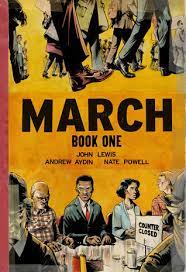March: Book One Book Summary
“March: Book One” is a powerful graphic novel that takes readers through the early life and experiences of civil rights icon John Lewis . Co-written by Lewis himself and Andrew Aydin , with stunning illustrations by Nate Powell, this book offers a unique and deeply personal perspective on the struggles and triumphs of the Civil Rights Movement.
The story begins in rural Alabama, where a young John Lewis witnesses firsthand the injustices of segregation and racial discrimination. Inspired by the teachings of Dr. Martin Luther King Jr. and the Montgomery Bus Boycott, Lewis became increasingly involved in the fight for equality. He joins the Nashville Student Movement and participates in nonviolent protests, including lunch counter sit-ins aimed at desegregating public spaces.
The graphic novel vividly portrays the courage and determination of Lewis and his fellow activists as they face discrimination, harassment, and even physical violence. We see them being denied service, arrested, and attacked by mobs, all while remaining committed to their cause and upholding the principles of nonviolence.
“March: Book One” doesn’t shy away from depicting the harsh realities of the time. We witness the fear, frustration, and anger felt by the activists, as well as the resilience and unwavering spirit that kept them going. The powerful imagery and Lewis’ own words capture the emotional depth of the struggle, allowing readers to connect with the characters on a personal level.
Beyond the individual experiences, the book also sheds light on the broader context of the Civil Rights Movement. We see the rise of key figures like Martin Luther King Jr. and the Student Nonviolent Coordinating Committee (SNCC), as well as the strategies and tactics employed by the movement to challenge segregation and fight for voting rights.
One of the most striking aspects of “March: Book One” is the use of graphic novel format. The illustrations are not simply decorative; they play a crucial role in conveying the story’s emotions, actions, and historical context. Powell’s art style is powerful and nuanced, effectively capturing the intensity of the protests, the determination of the activists, and the everyday realities of life under segregation.
“March: Book One” is not just a historical account; it’s a call to action. It reminds us of the ongoing fight for equality and justice and the importance of speaking out against oppression in all its forms. John Lewis’ story inspires us to stand up for what we believe in, even in the face of adversity, and never give up on pursuing a more just and equitable society.
This first book leaves readers eager to learn more about John Lewis’ journey and the ongoing fight for civil rights. It is a powerful introduction to a crucial chapter in American history, offering valuable lessons about courage, resilience, and the enduring power of nonviolent resistance.
